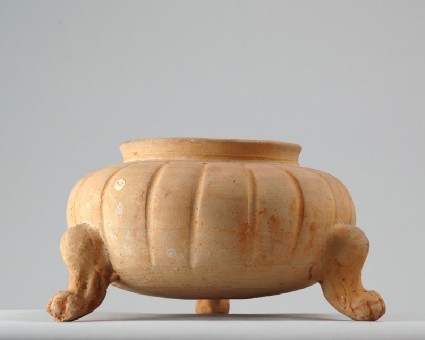Browse: 59 objects
Greenware incense burner with feet in the form of animal paws
- loan
-
Details
- Associated place
-
Asia › China › Guangdong province (place of creation)
- Date
-
8th - 9th century AD (AD 701 - 900)
Tang Dynasty (AD 618 - 907)
- Material and technique
- stoneware, thrown, with carved and hand-modelled decoration under a green glaze; unglazed base; glazed rim
- Dimensions
-
13 cm (height)
24 cm (diameter)
- Material index
- Technique index
- Object type index
- No. of items
- 1
- Credit line
- Lent by the Sir Alan Barlow Collection Trust.
- Accession no.
- LI1301.345
-
Further reading
University of Sussex, and Arts and Humanities Research Council, The Barlow Collection, supervised by Regina Krahl, Maurice Howard, and Aiden Leeves (Sussex: University of Sussex, 2006), no. C345
Glossary (2)
glaze, stoneware
-
glaze
Vitreous coating applied to the surface of a ceramic to make it impermeable or for decorative effect.
-
stoneware
Ceramic material made of clay which is fired to a temperature of c.1200-1300⁰c and is often buff or grey in colour.
Location
-
- currently in research collection
Objects are sometimes moved to a different location. Our object location data is usually updated on a monthly basis. Contact the Jameel Study Centre if you are planning to visit the museum to see a particular object on display, or would like to arrange an appointment to see an object in our reserve collections.
Publications online
-

The Barlow Collection
Although the shape of this vessel is more characteristic of ceramics from Henan and other kilns in the North of China, the body material and traces of finely crackled green glaze suggest a southern manufacture for this piece. A glaze of this type, which similarly displays a strong tendency to flake off the body, can be seen on vessels from kilns in Guangdong province, for example, the Shuiche kiln in Meixian (see Ceramic Finds from Tang and Song Kilns in Guangdong, Fung Ping Shan Museum, Hong Kong, 1985).
The vessel is of depressed globular form, with slightly flared neck, resting on three large feet in form of animal legs with paws clearly modelled. The sides of the vessel are structured by deep vertical grooves, which end at the lower part. The underside has a concave circular patch in the centre. The reddish-buff stoneware is now almost completely exposed, with only small traces of the olive-green glaze remaining in some of the recessed areas, but mostly flaked off, leaving only a faint matt layer which shows that the underside had been left unglazed.
© 2013 University of Oxford - Ashmolean Museum



